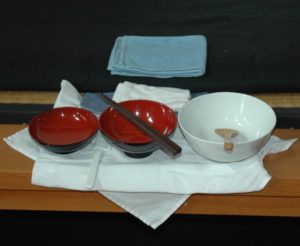Oryoki
 In the early centuries of Buddhism in Asia, Zen monks were primarily homeless wanderers, living a mindful, ascetic life, dedicated to maintaining and passing on the teachings. One of their few possessions was an eating bowl used to beg their daily meal from villagers and others who they might meet on the road.
In the early centuries of Buddhism in Asia, Zen monks were primarily homeless wanderers, living a mindful, ascetic life, dedicated to maintaining and passing on the teachings. One of their few possessions was an eating bowl used to beg their daily meal from villagers and others who they might meet on the road.
The development of a monastic system of practice during the T’ang dynasty (8th – 9th centuries) included creation of a formal, communal eating style. In place of the single begging bowl, monks used a set of bowls and utensils, kept together in a wrapping cloth, known as oryoki. Use of oryoki, preparation of the meal by the kitchen staff, and serving of the meal by the servers cultivates mindfulness and gratitude. In this way, meals become an extension of zazen. The tradition of oryoki has been transmitted to American Zen Centers and monasteries in the West.
The manual describes how to put together an oryoki , its use, and the serving of meals. It was written at Kannon Do in 1975 and made available as a hard copy booklet. Today it is available online as a PDF document. Click HERE to read or download the manual.

